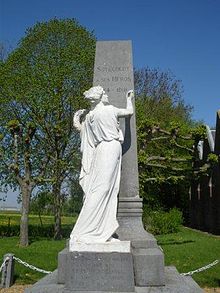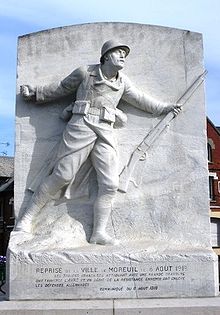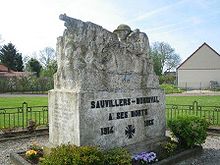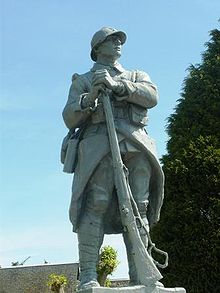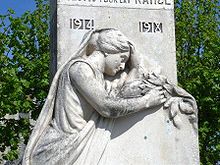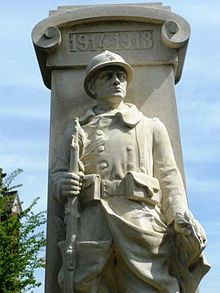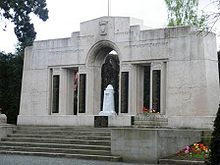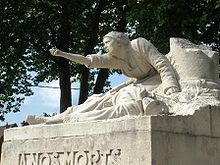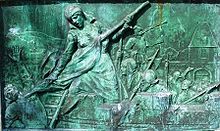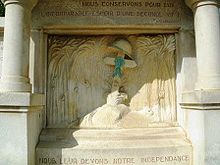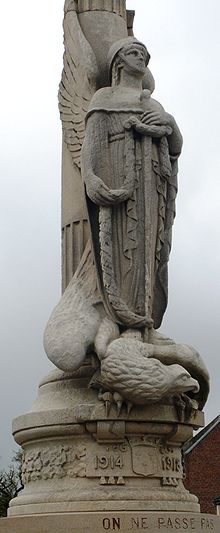- Monument aux Morts (Eastern Somme)
-
For an introduction, see Monument aux morts of the Western Somme.
This article covers some of the monuments aux morts in the eastern side of the Somme region.
Allonville
Allonville lies just a few kilometres from Amiens on the D919 road and this commune's monument aux morts involves the work of Athanase Fossé (1851–1923).The monument aux morts at Allonville stands by the church and was completed on 13 August 1920. Athanase Fossé did not charge for his work but gave his services free of charge as he had been born in Allonville and is in fact buried there. In the church of Allonville there is a relief by Fossé of Joan of Arc, shown emerging from the flames and thus delivered from death.
Athanase Fossé
Athanase Fossé had shown his artistic talent at a young age and was accepted at the Beaux-Arts in Amiens at the age of 14 where he studied under Le Tellier. He then moved to Paris where he was taught by Cavalier. He settled in Paris where he married his model, Clemétine Gaemans, but returned each year to Allonville for a holiday. Fossé carved two cariatides for the front of the Hôtel de Ville in Amiens. One of these represents "Justice" and holds a sword and the second "Vigilance", this figure holding a lighted torch.. The pediment contains the coat of arms of Amiens with sculptures representing "Les Arts et Les Lettres". For Péronne, Fossé executed a bronze statue of Marie Fouré, who was the heroine of the siege of Péronne in 1536. There are also works by Fossé in the Museum of Picardy, the Museum of Berny, the Museum Alfred Danicourt, and Saint-Victor hospital, all in Amiens as well as in the La Madeleine cemetery in Amiens. Another work of Athanase Fossé, called "Les Châtiments", can be seen in the Place de l'Église in Allonville.
By using the D1029, which runs east from Amiens, one can reach Villers-Bretonneux, Marcelcave, Harbonnières, Framerville-Rainecourt, Rosières-en-Santerre, Proyart and Soyécourt.
Villers-Bretonneux
Villers-Bretonneux is just 19 kilometres from Amiens. The area around this village saw much fighting between April and August 1918, being strategically placed in relation to the German Army's access to Amiens. In much earlier times Villers-Bretonneux had seen a clash on 27 November 1870 between the French and Prussian armies. The monument aux morts of Villers-Bretonneux features a statue of a woman symbolising grief. The woman is veiled, in tears and holds a crown of laurel.The sculpture dates from 1928 and is attributed to Mariene Hérant-Bender and at the back of the monument there is a cartouche by the sculptor André Del Debbio. The village had first expressed its wish to have a monument aux morts in 1920 but it was not in fact possible to erect the monument until 1928, as the village had been almost totally destroyed during the war.
There is a plaque at the foot of the Villers-Bretonneux monument aux morts which remembers the role played by the Australians in liberating the village. Just outside the village is the Villers-Bretonneux Memorial, an Australian National Memorial erected to commemorate all Australian soldiers who fought and died in France and Belgium during the First World War especially those of the dead whose graves are not known.
A photograph of this plaque is shown below.
The plaque at Villers-Bretonneux remembering the role played by the Australian Imperial Force in liberating the village
Marcelcave
Not far from Villers-Bretonneux and reached by leaving the D1029 and going south along the D23 is the village of Marcelcave. Here the monument aux morts features a sculpture by Louis Henri Leclabart which dates from 1925. Part of the cost of the monument was a gift from the commune of Canteleu, who had "adopted" Marcelcave during the war. It was often the case that villages not near to the front-line would adopt villages who were and give them financial and moral support. In Leclabart's work a wounded soldier is defended by his brother in arms, both positioned on a pedestal. The monument cost 15,000 francs.
Framerville-Rainecourt
At Framerville-Rainecourt the monument aux morts introduces us to the work of Jules Déchin (1869–1947). The sculpture features a soldier with rifle, leaning against a post which carries the inscription "Framerville". This work dates from 1925 and is situated by the old cemetery just by the church. The pedestal also carries an inscription acknowledging the soldiers of the British and Australian Armies who died in this area. The monument was inaugurated on 26 September 1926.
Jules Déchin
Jules Déchin was the sculptor of the monument erected to honour Général Ernest Barbot's 77e DI (Division d'Infanterie) at Souchez. Other works by Jules Déchin include:
- A baptismal font and other work in the church of Saint-Remi in Limé, Aisne.
- Work on the monument aux morts at Oisy in Aisne this in collaboration with the foundry Société Antoine Durenne.
- A statue of the sculptor Roland at Paul in Hérault.
- The statue of Joan of Arc for the church of Saint-Maurice in Chinon, Indre-et-Loire.
- A calvary for the church of Saint-Aignan in Baule, Loiret.[1]
- The monument aux morts for Aumont-Aubrac in Lozère, this a work in collaboration with Rombaux-Roland, the marbrier and L. Charbonnier a metal worker.
- Statue of Saint Thérèse for the church of Saint-Denis in Sainte-Adresse, Seine-Maritime.
- "Victory and the dying soldier" for the Chaulnes monument aux morts, this working with the foundry Alexis Rudier
- Work on the monument aux morts at Roye in the Somme. One relief shows Roye under artillery bombardment and the other shows the town emerging victorious from the war.
- A bust of Jean de La Fontaine in Fontenay-aux-Roses in Hauts-de-Seine.
- Several statues for the church of Saint-Pierre in Neuilly-sur-Seine sharing the work with the sculptor E. de Basly
- Furnishings for the church and a statue of Saint-Denis in Saint-André-du-Bas-Montreuil in Montreuil, Seine-Saint-Denis.
- The monument aux morts at Campagne-les-Hesdin in Nord Pas-de-Calais. It stands in the Rue Daniel Ranger near to the church. Déchin was also involved with the monuments at Beaurains, Feuchy, Guemps, Merlimont, Neuville-Vitasse, Pernes-les-Boulogne and Thiembronne and a second monument in Campagne-les-Hesdin. This second monument was dedicated to “ Aux enfants du canton de Campagne morts pour la France” and stands in the rue Saint-André. He was also the sculptor of the statue of François André who was the mayor of Lille in 1792 and then from 1795 to 1796. It was André who led the people of Lille in their resistance of the Austrian invaders. The statue stands in Lille and has some fine bas-reliefs.
Déchin studied in Lille at the Écoles Académiques de Lille and one can see several of his works in that city and in the Somme region. He worked extensively with the founders Société Antoine Durenne and they marketed his pieces "Armistice", "Poilu morant", "Poilu E.K", "France victorieuse" and "Applique E.J.". These can be seen in many locations throughout France. He was also the sculptor of the monument aux morts at Épernay, Lezennes and Avocourt.
Société Antoine Durenne
Société Antoine Durenne of Somerville in the Haut-Marne were founders who worked with several sculptors and for the most part identified which edition was by which sculptor. They sold several pieces by Jules Déchin and also worked with Eugène-Paul Benet, Prosper-Jean Lecourtier, Eugène Piron and Leon Leyritz.
The Société Antoine Durenne range included
- "Applique E.J." by Louis Déchin
- "Armistice" by Louis Déchin
- "Buste de poilu" by Eugène Paul Benet
- "Buste de poilu No.107" by Diosi
- "Coq gaulois numbers 1, 2, 3, A and B" all by Prosper-Jean Lecourtier.
- "France victorieuse" by Louis Déchin
- "On ne passé pas" by Eugène Piron.
- "Poilu E.K." by Louis Déchin
- "Poilu mourant" by Louis Déchin
- "Poilu victorieux" by Eugène Paul Benet
- "Soldat vainqueur" by Leon Leyritz.
Harbonnières
Easily reached from Framerville-Rainecourt and on the D41 is the village of Harbonnières which has a most beautiful monument aux morts, the work of Georges Roty. The monument cost 19,000 francs, of which 16,000 francs was raised by public subscription. Inauguration took place on 29 October 1922. There is no record of Georges Roty having worked on any other monument aux morts either in Picardy or other parts of France although he was one of the sculptors taking part in the competition organised to select a monument aux morts at Montdidier. It is a poignant composition with a woman crying over the helmet of a dead soldier. She holds both palm and laurel.
Guillaucourt
Guillaucourt lies on the D136 and not far from Harbonnières. Here the monument aux morts dates from 1922 and was erected by Teisseire, a Vichy master builder under the direction of the architect Paul Martin. The sculptural work was by Auguste Carvin. The monument cost 11,481 francs, of which only 600 francs came from the local council, with almost 11,000 francs being raised by public subscription. Inauguration took place on 22 October 1922. The central figure is a veiled widow, her head bowed, placing some laurel on the helmet of a deceased soldier.
Rosières-en-Santerre
Rosières-en-Santerre lies at the junction of the D28 and D329 roads, and her monument aux morts dates from 1922. The sculptor, Auguste Carvin, was chosen, after an open competition, and his bid of 6,000 francs accepted. The monument was inaugurated on 1 November 1922. The central figure of the monument is a poilu ("poilu debout dit le sacrifice") standing on a pedestal, his face looking upwards, his hand on his chest and two bas-reliefs below show the mother and wife of a dead soldier kneeling before his grave; the mother holds a bouquet of roses. On the other side of the central pedestal are a further two bas-reliefs. One of these reliefs features the tomb of a soldier. In the background we see a village and can make out the bell-tower. On the right a sower turns towards the tomb as though in hommage- he is perhaps sowing the seeds of the future.
Proyart
From Rosières-en-Santerre head north on the D329, crossing the D1029 and one will reach the commune of Proyart.
Here we find what was certainly the most expensive monument aux morts erected in the Somme region. It was from the Marbreries Générales Gourdon range and cost 320,000 francs! It was the most expensive item in Gourdon's catalogue and they only sold the one! It consists of an "arc de triomphe" and under that arch stands a soldier carved from white marble. On the sides of the arch are some splendid reliefs.
The monument was erected in 1924 and the land involved was the gift of Mr.and Mrs Normand who also put up most of the funds involved in erecting the monument. Mr.Normand was a wine merchant in the Champagne area. The Normands had lost their only son,killed in combat in the Great War and the monument stands in the grounds of the local chateau owned by the Normand family. Another contributor to the cost of this monument was the town of Cognac who had "adopted" Proyart during the war. The monument was inaugurated on 28 September 1924 by General de Castelnau who had commanded the French army in the Somme from September 1914 to August 1915. On the sides of the arch are three bas-reliefs: "Le Départ", "L’assaut à Proyart", and "La France reconnaissante à Proyart."
The relief "L’assaut à Proyart" shows eight soldiers advancing towards the enemy lines including one with field glasses, another on look-out and a third with a periscope. In the distance another group of soldiers are in the same trench. The relief shows trees which had been destroyed and the barbed wire of no man's land. The relief "Le Départ" portrays a soldier saying goodbye to his family; his wife, his child, his mother, all in front of the family home. In the rear we see a village and its church. The relief "La France reconnaissante" is an allegory of a victorious France wearing a phrygien bonnet and a crown of laurel and embracing a soldier holding the national flag. A battalion of soldiers is shown marching by and we see the Arc de Triomphe in Paris encircled by torches of fire.[2].
The central figure of the soldier is carved from marble and the rifle is made from cast iron. The soldier's foot rests on a German helmet (the point at the top of the helmet is no longer there).
Soyécourt
At the village of Soyécourt we have an example of the work in marble entitled "Histoire écrivant" which was marketed by the marbriers Établissements Rombaux-Roland and can be seen throughout France. This monument was erected in 1925; the municipal council had decided on a monument on 8 December 1924 and Établissements Rombaux-Roland executed it in August 1925 for 17,675 francs. A major contribution to the cost was made by the town of Châtellerault who had "adopted" Soyécourt. Établissements Rombaux-Roland of Jeumont were a major foundry and marketed an extensive range of statues through a comprehensive catalogue. They were one of the foundries who did not to identify the sculptors with whom they were involved. Their range included:-
- "Au mépris du danger"
- "Coq (sur demi-sphere laurée)"
- "Coq (sur sphere)"
- "Coq (sur terrasse)"
- "Coq sur casque lauré"
- "France au drapeau No.999"
- "Histoire écrivant"
- "Poilu"
- "Poilu aux lauriers"
- "Stele a la deuillante".
We can see examples of Établissements Rombaux-Roland editions at Marquaix, Domart-Becquincourt, Roisel and Soyécourt. At Marquaix, which lies on the D6 running east from Peronne, we have an example of "France au drapeau No.999". Inauguration took place on 28 August 1927 and the cost of the monument was 9,750 francs. This Établissements Rombaux-Roland piece is well known throughout France. At Domart-Becquincourt, a commune 30 miles east of Amiens, we see an example of "Au mépris du danger ". The total cost was 10,500 francs. This work also appears throughout France either in bronze or marble.
Corbie
At Corbie the monument aux morts was the work of Albert-Dominique Roze and dates from 1923. A mother is shown telling a young child of the sacrifice made by his father and others. She holds in her hand the names of those who had died, inscribed on a scroll. A committee was formed on 25 October 1923 and subsequently received a contribution raised by the community of 37,000 francs. The Corbie monument features a curved wall at the rear of the statue on which are carved the names of the dead. The monument is similar to that at Cayeux-sur-Mer.
Thézy-Glimont
The monument aux morts at Thézy-Glimont features a carving by Valentin-Charles Molliens (1868–1937). The village also has a statue to Mosel Eloi (1735–1809) who invented a special tool used for lifting peat/turf.
Valentin-Charles Molliens
Valentin-Charles Molliens was born in 1868 at Argoeuvres and died in 1937. He had his studio in Longpré-les-Amiens and attended the Ecole régionale des Beaux-Arts in Amiens and was much influenced by the teaching there of Alexandre Falguière. He loved to carve floral subjects and his work includes the carvings of animals on the famous Hôtel Bouctot Vagniez in Amiens. He exhibited several times at the Société des Amis des Arts. Molliens is attributed with the monument aux morts at Breuil, Etalon, Le Quesnel, Poix-de-Picardie and Thézy-Glimont.
Miraumont
The monument aux morts at Miraumont has an almost identical sculpture to that at Thézy-Glimont but this was supplied by Gaudier-Rembaux so perhaps they took the idea from Molliens. The sculpture features a child holding a laurel branch towards the croix de guerre. As already mentioned, Molliens’ studio was at Longpré-les-Amiens and in the church there, the Church of St.Lèger, there is a parish monument aux morts which was a collaboration between the marbrier Marcel Sueur and Molliens. Molliens’ work here is a medallion, the work dating from 1909.
Travel a little further south along the D935 and one can reach the communes of Morisel and Moreuil.
Moreuil
At Moreuil the monument aux morts is a work in marble by Albert-Dominique Roze and is perhaps his best work and certainly best known. A soldier is seen in the act of throwing a grenade. The monument commemorates in particular the release of Moreuil from German occupation on 8 August 1918. It was inaugurated on 12 October 1924 by General Charles Nollet, the Minister of War. At the back of the monument is a medallion commemorating the soldiers of the 1870 war.
Morisel
At Morisel the commune's monument aux morts stands in the Place de l'Église and features Charles-Henri Pourquet's "Résistance". Made in a series, it achieved great success throughout France and represented the Verdun sentiment "Ils ne passeront pas". The same piece can be found at Dompierre-sur Authie. At Morisel the committee organising the monument was set up in 1931 and dissolved in 1932.
Charles-Henri Pourquet
Pourquet was born in 1877 and died in 1943. The bronze at Morisel was produced by Fonderie d'art du Val d'Osne in 1921 and was number 854 in their catalogue. A version in stone was issued by the sculptor's own studio. Pourquet was born at Colombes in Hauts-de-Seine and lived in Paris. A version of this piece in plaster was presented at Paris in 1921 at the Salon de la Société des Artistes Français. Fonderie d'art du Val d'Osne were a major French foundry who like Société Antoine Durenne mentioned earlier were to see the market for works suitable for war memorials. It had its headquarters in Paris and a factory at Osne-le-Val in the Haute-Marne. Fonderie d'art du Val d'Osne offered a wide selection of bronze and marble editions and worked with Pourquet, Georges Vérez and many other sculptors.
At Omiécourt, for instance, a commune near to Chaulnes, the monument aux morts features a Fonderie d'art du Val d'Osne piece which used a sculpture by Georges Vérez (1877–1933).
We can see a fine work by Pourquet at Richebourg, a commune formed by a merger between Richebourg Saint Vaast and Richebourg L’Avoué in 1971. In effect the two communes already shared their monument aux morts. The monument aux morts stands in front of the church and features the body of a dead soldier who lies in the pose of some medieval knight just returned from the crusades. His hands lay crossed on his chest and a flag is draped across his body. The monument was inaugurated on the 9th August 1923.
Georges Vérez
Georges Vérez was born in Lille in the Nord region and lived in Paris. His winged figure of "Victory" (n° 870 in Fonderie d'art du Val d'Osne catalogue) is one of a number in the series.
Vérez was also the sculptor of the Monument de la Victoire in the Jardin Baptiste in Cambrai,this monument commemorating the 1914–1918 war. He was also the sculptor of the monument aux morts in the cemetery at Pantin in Seine-St-Denis in Ile-De-France.This work is dated 1922. He was also the sculptor of the monument aux morts at Pau.
The Fonderie d'art du Val d'Osne range included:-
- "L’Attaque no.877" by David.
- "Buste No.505" by Pourquet
- "Buste No.506" by Breton
- "Buste No.512" by Poublan
- "Buste de poilu No.504 "by Lorenzi
- "Coq gaulois No.259" by Sanchez
- "Coq gaulois sur terrasse No.261" by Lecourtier
- "Grenadier No.857" by Poublan
- "Jeanne d'Arc" by de Gregorio
- "Plaquette au poilu étreignant le drapeau" by Breton
- "Poilu No.853" by Pourquet
- "Poilu no.856" by Graf
- "Poilu No.893" by Georges Vérez
- "Poilu étreignant le drapeau (avec croix) No.858" by Breton
- "Poilu gisant" by Pourquet
- "Relief circulaire au poilu étreignant le drapeau avec croix" by Breton
- "Resistance No.854" by Pourquet
- "Victoire No.860" by Dame
- "Victoire No.872" by Graf
- "Victoire ailee No.870" by Georges Vérez
- "La victoire en chantant No.861" by Richefeu.
Sauvillers-Mongival
Here the monument aux morts features a work by Marius Giot (1897–1980). The monument dates from 1935 and features a machine-gunner. The late date here is explained by the fact that Sauvillers-Mongival was almost totally destroyed during the 1914–1918 war, only three buildings surviving. A major reconstruction was therefore necessary after 1918
Marius Giot
Giot, who was born in Étoges in the Marne, also worked on the monument aux morts at Broyes and Sézanne in the Marne region.
La Faloise
From Sauvillers-Mongival one can move on to the commune of La Faloise which lies in the Noye valley and can be reached by the D193. It lies midway between Ailly-sur-Noye and Breteuil and has a moving monument aux morts, visible as one enters the village (on the right coming from Folleville). A very original sculptural composition it features an old man, a farmer and perhaps a father, taking time off from his work to look at a grave of a dead soldier. He holds a long narrow spade. The monument dates from 1923.
Pierrepont-sur-Avre
At Pierrepont-sur-Avre the monument aux morts stands in front of the church and the work was given the name "statuaire de la douleur" when first shown in the revue L’Art funeraire et commemorative. It is a thoughtful sculptural composition by Charles-Henri Pourquet and was completed in 1926. This village lost 14 of her 465 inhabitants in the Great War. Pourquet was paid 13,500 francs for his work. The monument is worked in Savonnieres stone. The soldier in the high relief composition is draped in the National Flag and in the second, in low relief, we see crosses from the military cemetery and in the background an allegory of the Nation holding in extended arms two crowns of laurel. The addition of numerous crosses seems to underline the number of deaths being commemorated and is highly effective.
Davenescourt
Just by Pierrepont-sur-Avre and on the junction of the D160/ D41 is the village of Davenescourt. The monument aux morts stands in the Place de la Mairie and is an Albert-Dominique Roze work dating from 1928. It features a standing but noticeably older soldier perhaps a reservist. This village lost 30 inhabitants out of 653. On 3 August 1919 the municipal council voted the sum of 6,000 to cover the cost of a monument. The soldier holds his helmet and has in front of him a list of the dead.
East from Davenescourt and eastward along the D160 are the villages of Guerbigny and Andechy.
Guerbigny
At Guerbigny the monument aux morts is a Leyritz/Durenne "Soldat Vainqueur" and dates from 1922 . It stands in the Place de l'Eglise. The community lost 16 inhabitants out of a total population of 482 and on 6 January 1920 the local council voted 1,000 francs to cover the erection of a monument aux morts. The builders Massin Fils et Boulogne of Roye erected the monument and the Leynitz statue on the top cost 6,700 francs. Of this 6,700 francs, 2,500 francs were voted by the council and 4,200 francs was raised by subscription. Leyritz's statue is very popular and can be seen elsewhere in France- Le Fau-de-Peyre in Lozère, Mareuil-sur-Arnon in Cher, Saint-Denis-en-Margeride in Lozère, and at Saint-Leger-sous-Brienne in the Aube.
Leon Leyritz
Leon Leyritz (1888–1976) was a sculptor and designer and is perhaps best known for his bust of Ravel. He also designed the apartment which Ravel kept in the house of his brother Edouard. Leyritz also worked on the décor for the ballet version of Ravel's "Bolero". Leyritz worked on several monument aux morts and the Fonderie Durenne reproduced his "Soldat Vainqueur" in several locations.
Andechy
At Andechy the monument aux morts is an emotive sculpture by Georges Legrand. This was another village completely destroyed during the Great War and very much a frontline village. The Battle of Andechy took place on the 4 and 5 November 1914. There is a German cemetery at Andechy with 3,000 graves.
Georges LeGrand
Georges LeGrand was born in Amiens and exhibited at the la Société des Amis des Arts in 1931 and 1933.. He was responsible for the monument aux morts at Andechy, Hangest-en-Santerre and Morchain.
Bouchoir
At Bouchoir the monument aux morts features an allegory of a woman holding a dying soldier in her arms and placing a crown of laurel on his head. It is the work of Victor Lefranc Robillard of Montdidier and dates from 1926. On 2 March 1926 the local authority decided to complete the monument aux morts offered to Bouchoir by a Franco- American committee and a contract was signed with Victor Lefranc Robillard to add a sculptured group. The "Commission d'examen des monuments de la Somme" were however critical of the sculpture saying that its proportions were at variance with the monument itself and even today the sculpture stands alone and apart from the main monument.
Le Quesnel
At Le Quesnel the monument features the figure of a poilu. It is at Le Quesnel on the road from Amiens to Roye that we find a fine monument celebrating the exploits of the Canadian Army during the Battle of Amiens from 8 to 11 August 1918. The Germans had suddenly attacked the British Armies on the Western Front and by 5 April they had been beaten back to a position just in front of Amiens but the Germans were halted there by a brigade of Canadian Cavalry who at the time were fighting as both a cavalry unit and infantry. Le Quesnel lies on the north side of the D 934 between Amiens and Roye .
Hangest-en-Santerre
Hangest-en-Santerre lies on the D41. Here we see the monument aux morts which dates from 1923. The decision to erect a monument aux morts had been taken on 13 July 1923 and a contract made with Georges Legrand whose wife was a native of the village.
Arvillers
Arvillers lies on the D54 and here is an example of "Le Soldat au drapeau", which was number 2139 in Marbreries Générales Gourdon's catalogue. The work at Arvillers was dated 1923. The choice of statue was made by the ex-soldiers of the town. This work can be seen on monuments throughout France.
Amiens
In Amiens itself there are three monument aux morts all by Albert-Dominique Roze. One is in Amiens Cathedral. This was completed in 1923 and inaugurated on 6 April 1924. In Roze's composition a dead soldier lies in the centre of the relief and on his right are his wife and child and on the left his father and mother. All appear in tears but the Virgin Mary stands above the soldier's body with arms spread as though consoling them all. The main Roze work is Amiens's monument aux morts and as one would expects the monument aux morts for the capital of Picardy is of huge proportions and stands in the Place du Maréchal Foch. It remembers not only the 2,666 Amienois who died in the Great War but also the fact that Amiens was a garrison town and that troops left there for the front. Work on the monument was started in 1927 and the inauguration took place on 14 April 1929. On the eastern side two foot soldiers hold hands. One is young the other older and thus represent the two generations involved in the war and underlines the brotherhood felt on the front line. On the southern side, a cavalryman and an aviator are featured with propeller and bomb. On the eastern side an engineer with rope and hammer and a tank driver complete with caterpillar and conning tower are featured and on the northern side are seen an artilleryman with canon and shell and a marine. At the top a figure representing "Victory" holds a pen and writes the names of the dead on the bough of a tree. The funds for this monument were financed by subscription, tombolas, concerts and galas. Jules Derivery and Denis Sosthene carried out the marble work involved. Originally the plan was for a monument to commemorate both allies and those citizens of Amiens who died in the Great War. It was to be called the "panthéon interallie" and it was planned to place it at the exit from Amiens that leads to Albert and the battlefield of the Somme. However this idea was abandoned in favour of a monument just remembering those from Amiens who died. The third monument stands in the National Military Cemetery at Saint-Acheul in Amiens. It was inaugurated on 27 July 1924 and was commissioned by "Le Souvenir Français" which had since its foundation in 1887, worked to commemorate those soldiers who died on the field of battle. In white stone it is a thoughtful work.[says who?] The reflective figure of a woman sitting in front of the monument was added in 1925.
In the gallery below are several images of the Amiens monument aux morts.
Vignacourt
Vignacourt lies 16 kilometres northwest of Amiens at the junction of the D12 and D49. The monument aux mort stands in the cemetery and is another work by Albert-Dominique Roze who explores a common theme encountered in monument aux morts; that of the widow holding her child. The memorial cost 22,000 francs and was inaugurated on 7 August 1921. In the same cemetery another monument by Roze and standing in the British section of the cemetery remembers those allied soldiers buried there. The monument in the British cemetery was erected by the village in honour of the Commonwealth dead and is a statue of a French soldier, on the base of which are engraved the words: "Frères D'armes de L'Armèe Britannique, tombes au Champ D'Honneur, dormez en paix. Nous veillons sur vous." ("Brothers in arms of the British Army, fallen on the field of honour, sleep in peace; we are watching over you."). The cemetery was designed by Sir Reginald Blomfield
Bougainville
Bougainville also lies to the west of Amiens and here one can see another work by Albert-Dominique Roze, this entitled "The defence of the flag". It features two soldiers defending the French flag, one holds a rifle and the other the flag. The monument was inaugurated on 25 September 1921 and was funded by a gift from the mother of a young Bougainville man killed in the war. Roze, it seems, was a friend of the family. The work is dated 1921. Roze has returned to his theme of "brothers in arms". The reverse of the monument carries an inscription remembering the victims of the war of 1870. Bougainville lies some 23 kilometres west of Amiens in the direction of Saveuse and Ferrières.
Poix-de-Picardie
Poix-de-Picardie also lies west of Amiens and can be reached using the D1029. The monument aux morts in this commune, dates from 1920 and was the work of the builders Galland and Grujon and the architect Dupont. It was Valentin-Charles Molliens who sculpted the relief at a cost of 2,000 francs. The relief shows a young man embracing the flag with a crown of laurel in front of him. Poix-de-Picardie lies at the junction of the N1 and N29, 20 miles south west of Amiens and has a fine 16th century church.
Doullens
Doullens lies north from Amiens and the monument aux morts dates from 1925 and involves sculptural work by Louis Voclin and Attenni. Marcel Gogois was the architect and the monument was carved from Euville stone. The marble pedestal was carved by Attenni and inauguration took place on 11 October 1925.
Rubempré
In the commune of Rubempré we have two examples of the work of Pierre Ansart; that in the church and the public monument aux morts. In both cases Ansart worked with Marcel Sueur, the Amiens Marbrier. The monument aux morts in the parish church is a most interesting one and in the church there is also a second commemoration of the 1914–1918 war, this being a painting by the then curate. The parish church monument lies against the wall south of the nave under the crucifix. Apart from a list of the men remembered, a dead soldier in relief is etched on a panel. It is a stylised representation with large contours and painted in red. A smaller plaque has been added to remember the dead of the 1939–1945 conflict. The dead soldier lies flat his hands crossed in prayer with the inscription "in gloria, in pace" and then the coat of arms of Rubempré. The Ansart/Sueur public monument aux morts in the rue Richard Vilbert is a sculpture and mosaic with a croix de guerre and a helmet. This dates from 1920
Albert
The D929 running north west from Amiens takes us to Albert and from there one can reach Auchonvillers, and Beaumont Hamel and there see the works of Charles Gern
Charles Gern
Gern was born at Kaiserlautern in Germany and was a student of Joseph Wackerle at the Beaux-Arts in Munich. He lived for some time in Albert. He exhibited at the Paris Salon in 1925 and was responsible for some beautiful work at Albert, Auchonvillers and Beaumont and Hamel.
At Auchonvillers the monument aux morts stands near to the church. A female figure stands with arms outstretched and appears to be acknowledging those whose names are listed on the left and right sides of the triptych. Carved from Euville stone it was erected in 1936. When Gern was given the commission in 1932 he was in Auchonvillers at the time doing some work on the church..The contract with Gern was for 22,000 francs. Progress was slow and in October 1936 Gern had to leave Albert for Menton as he was sick and because of Gern's illness there was a delay in completion and Gern had to leave the final work to the Albert cement maker Joseph Gelmini.
The two communes of Beaumont and Hamel lie side by side and were in the thick of fighting during the Battle of the Somme. Indeed the two villages were destroyed during the war. In the surrounding area are numerous cemeteries. The French and British cemeteries of Serre-Hébuterne lie just by Beaumont as does the haunting Beaumont-Hamel Newfoundland Memorial park. Gern was given a contract on 27 June 1933 for both the Beaumont and Hamel monument aux morts. How ironic that two of the most beautiful monument aux morts in France were carved by a German!
At Albert the imposing monument aux morts stands in a public garden in the rue Victor-Hugo and was completed in 1936. The monument features two bas-reliefs, "L’Adieu" and the" Le Deuil" (Grief).
In the gallery below are some images of Gern's work at Beaumont, Hamel and Auchonvillers.
Péronne
It was Paul Auban who sculpted this most famous monument aux morts- "Picarde maudissant la guerre" situated in the rue Beranger. In this powerful piece a woman leans over a dead body and shakes her fist towards the unseen enemy in a gesture of vengeance. There are also bas-reliefs signed by Paul Theunissen and the monument was completed in 1926. It was inaugurated on 20 June 1926. Auban was also one of the sculptors who worked on the victory Fontaine Sube at Reims. The other sculptors were Louis Baralis, Joseph Wary and Paul Gasq.
Theunissen's two reliefs show a scene from the trenches in 1916 and a scene from Charles Quint's unsuccessful siege of 1536. Catherine of Poix, also known as "Marie Fouré" led the defence of the town and was said to have thrown a Spaniard off the top of the wall. Here are photographs of the two reliefs taken on a visit to Péronne in June 2010.
Auban was also the sculptor of the monument aux morts of Avelin which lies 10 kilometres south of Lille.
Bouchavesnes-Bergen
Bouchavesnes-Bergen lies north from Péronne and here one sees the work of Michelet Firmin-Marcelin (1875–1951). The monument aux morts dates from 1926. There is also a statue of Maréchal Foch in Bouchavesnes-Bergen. The reconstruction of the village and the statue of Maréchal Foch as well as the monument aux morts, were financed by way of gifts from a rich Norwegian. The local authorities voted to erect a monument on 7 August 1925. On 4 July 1926 on the tenth anniversary of the Battle of the Somme the monument was inaugurated in the presence of the sculptor, Maréchal Foch and Senator Klotz. In 1996 the monument collapsed and was replaced by a granite stele.
Michelet Firmin-Marcelin
Michelet Firmin-Marcelin came from Tarbes in the Hautes-Pyrénées. It was Firmin-Marcelin who was responsible for the monument aux morts in the College Stanislas in Paris, and the "Monument du Souvenir des enfants des Hautes-Pyrénées morts pour la France" in Tarbes. He also sculpted the statues of Ferdinand Foch at Rethondes, Tarbes and Valentine as well as the bronze statue of D’Artagnan (one of Alexandre Dumas' three musketeers) at Auch. Firmin Marcelin also executed the murals (reliefs) in the chapel of the Memorial to the Battles of the Marne at Dormans.
Barleux
Barleux lies south from Péronne on the D4164. The monument aux morts features an allegory of the French Republic holding a flag and a crown of laurel.This is the work of the sculptor Armanet from Porcieu-Amblagnieu in Rhône-Alpes.
The D934 running south east from Amiens takes ones to Roye and from there one can reach Etalon, Nesle, Bethencourt and Morchain as well as Chaulnes, and Omiecourt.
Roye
At Roye and standing in the Place des Combattants in the centre of the town is one of the most remarkable monument aux morts in the Somme region. Carved in stone from Romaneche in Ain this is a work by Jules Déchin and the entrepreneur Petit, and was based on a project by the Grand Prix de Rome winning architect Rubin. This composition juxtaposes allegories of war and peace. On one side of the monument is an allegory of the town of Roye, crowned and holding a palm on which is hooked the Croix de guerre with the helmet of a soldier placed on a broken cross at its feet and on the other is a representation of the bombardment of Roye and the sufferings of the war- a woman and her child sit and the child is clearly disturbed and in the background we see the ruins of the town with what is left of the church of Saint-Pierre. The monument cost 80,000 francs and was inaugurated on 21 July 1927 by Édouard Herriot.
Nesle
From Roye one can take the D930 to reach Nesle. This is an old town 20 kilometres south of Péronne and indeed we are reminded of Blondel de Nesle, the 12th century Picard poet, who was the favourite of Richard Coeur de Lion/King Richard I of England. The monument aux morts was the work of the sculptor Emile Ancellin (1880–1941) who was born and lived in Nesle. The monument dates from 1922.
Morchain
The commune of Morchain, which lies on the D139 and D142 roads 48 kilometres east of Amiens, has another important work by Georges Legrand.
Etalon
Etalon lies to the north of Roye. The so-called "La croix de bois" relief, a work by Valentin-Charles Molliens is the main feature of the monument aux morts which stands near to the village church. A maquette of this work was shown at the exhibition of the Société des Amis des Arts du département de la Somme in April 1929 under the number 249. This stark and atmospheric relief shows a cross with the helmet of a dead soldier perched on the top. It stands in a field of corn with corn-poppies growing around.
Chaulnes
Return to Roye and drive north on the D1017 and take the D142 to Chaulnes. The monument aux morts at Chaulnes was completed by Jules Déchin in 1920. It involves a combination of "La France victorieuse" and "Le Poilu morant" both heavily marketed in France by Société Antoine Durenne but normally as separate pieces. It is not often that these two pieces are put together and the effect is powerful. There are incidentally several instances where Jules Déchin's "Le Poulu mourant" is paired with Benet's "Poilu victorieux". Benet was another sculptor with whom Société Antoine Durenne worked extensively. Inauguration of the Chaulnes monument took place on 3 August 1924.
Bray-sur-Somme
At Bray-sur-Somme one has the opportunity to see a monument aux morts which features work by the Albert based marbrier, Boindin Lechien . It was inaugurated on 5 October 1924. The monument carries the names of several of the Great War battles. The central feature is a soldier, on foot, and holding the flag. Boindin also worked on the monument aux morts at Dernacourt. Bray-sur-Somme is situated on the D1 and D329 road junction, some 20 miles (32 km) north east of Amiens.
Montdidier
The pyramid shaped monument aux morts of Montdidier was completed in 1923 and is to be found in the Place de la République. A committee charged with constructing the monument aux morts was created in November 1920 and in October 1922 this committee organised a competition open to architects, artists and sculptors. The first prize went to the parisienne architects Andre Japy and Alfred Tord. The statues represent the two generations involved in the war and were the work of Albert-Dominique Roze. Total cost of the monument was 38,000 francs.
Montauban-de-Picardie
Montauban-de-Picardie. This commune is situated on the D64 some 32 kilometres northeast of Amiens and her monument aux morts features the same composition as that seen on the monument aux morts at Guillaucourt.
Fouilloy
At the commune of Fouilly one can see a monument aux morts by Établissements H.Jacomet of Villedieu in the Vaucluse, this another of the foundries who supplied pieces for memorials in the Somme and elsewhere. Établissements H.Jacomet's main products were the pieces « Arc de Triomphe » and « Poilu », the piece « Poilu baionnette au canon », and the piece « Victoire ». These were all works by Etienne Camus the Toulouse sculptor. « Poilu » can be seen in many villages in the Somme region (Estrées-Deniécourt, Grouches-Luchuel, Le Boisle, Maison-Ponthieu, etc.).
Mailly-Maillet
At Mailly-Maillet the monument aux morts was the work of the Albert marbrier Dessein-Houriez and dates from 1922. It is an allegory representing France holding a sword and a wreath and crushing a German eagle. The inauguration took place on 30 July 1922.
Saint-Leger-les-Domart
At Saint-Leger-les-Domart the monument aux morts stands in the rue Anatole Jovelet. A poilu stands with arms crossed and unarmed,. It is the work of the founder Alexis Rudier and the marbrier Jules Bouldoduc of Wimereux. The pedestal is made from Lune stone. The statue was inaugurated on 6 November 1921. There are few statues in France featuring such a soldier and there are those who interpret the pose as that of resistance whilst others have suggested pacifism.
Gueudecourt
In the commune of Gueudecourt one can see another work by Jules Déchin called "Armistice" with Déchin working with the marbrier Louis Polard. The monument was erected in October 1928 and the cost was 10,500 francs of which 8,000 were given by the town of Monaco who had "adopted" Gueudecourt. The monument aux morts was inaugurated in April 1929. In the work "Armistice", the soldier holds his right arm forward and at his feet is a milestone indicating "Compiègne and Rethondes" It was there that the armistice was signed and it is to that point that the poilu is reaching out!.
See also
Notes
- ^ http://www.culture.gouv.fr/public/mistral/palsri_fr?ACTION=CHERCHER&FIELD_1=REF&VALUE_1=IM45000649. The Baule calvary
- ^ [1]. Further details on Proyart monument
References
- Patrimoine de France-Source of information on monument aux morts (French)
- FranceGenWeb-Source of information on monument aux morts (French)
- Article on Général Ernest Barbot
External links
- Sites of Memory (Historical markers, memorials, monuments, and cemeteries worldwide)
- A National Archives article giving further information on the memorial at Dormans which is dedicated to the First and Second Battles of the Marne
- A further National Archives article dealing with the Villers-Bretonneux Australian Memorial
Categories:- French sculpture
- World War I memorials in France
Wikimedia Foundation. 2010.

















